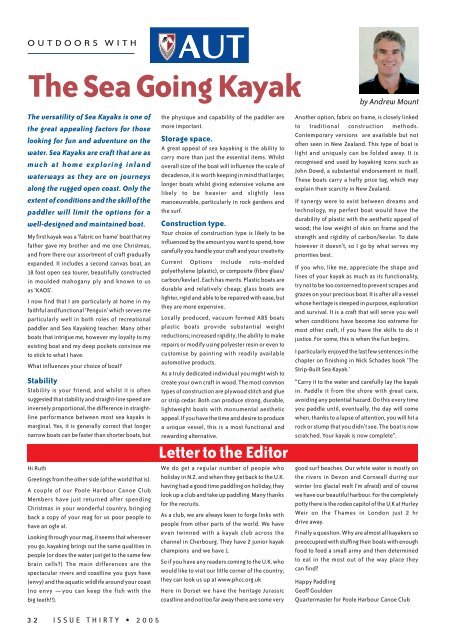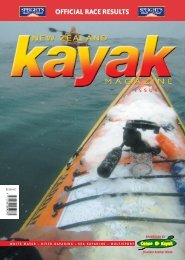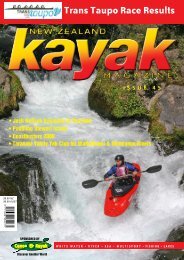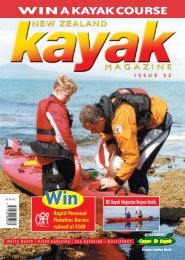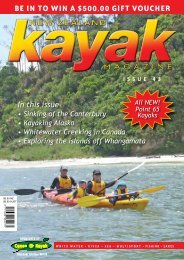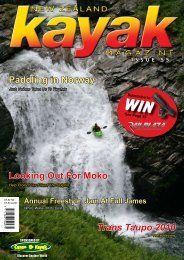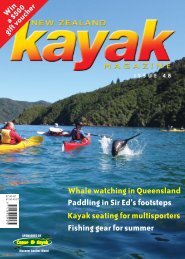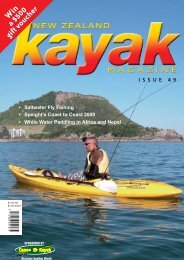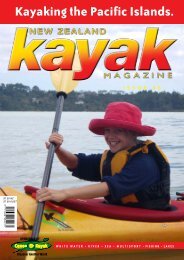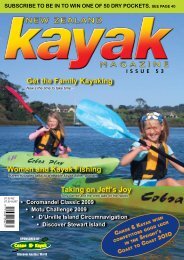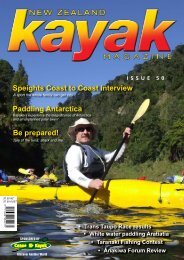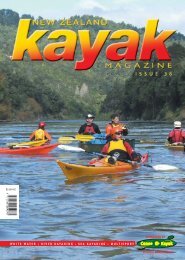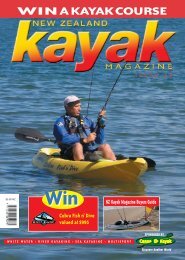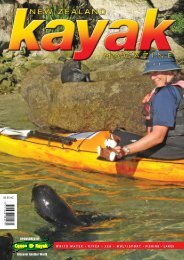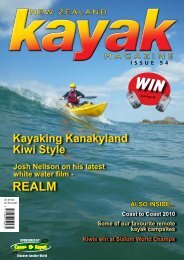C&K mag #30 sp - Canoe & Kayak
C&K mag #30 sp - Canoe & Kayak
C&K mag #30 sp - Canoe & Kayak
You also want an ePaper? Increase the reach of your titles
YUMPU automatically turns print PDFs into web optimized ePapers that Google loves.
OUTDOORS WITH<br />
The Sea Going <strong>Kayak</strong><br />
The versatility of Sea <strong>Kayak</strong>s is one of<br />
the great appealing factors for those<br />
looking for fun and adventure on the<br />
water. Sea <strong>Kayak</strong>s are craft that are as<br />
much at home exploring inland<br />
waterways as they are on journeys<br />
along the rugged open coast. Only the<br />
extent of conditions and the skill of the<br />
paddler will limit the options for a<br />
well-designed and maintained boat.<br />
My first kayak was a ‘fabric on frame’ boat that my<br />
father gave my brother and me one Christmas,<br />
and from there our assortment of craft gradually<br />
expanded. It includes a second canvas boat, an<br />
18 foot open sea tourer, beautifully constructed<br />
in moulded mahogany ply and known to us<br />
as ‘KAOS’.<br />
I now find that I am particularly at home in my<br />
faithful and functional ‘Penguin’ which serves me<br />
particularly well in both roles of recreational<br />
paddler and Sea <strong>Kayak</strong>ing teacher. Many other<br />
boats that intrigue me, however my loyalty to my<br />
existing boat and my deep pockets convince me<br />
to stick to what I have.<br />
What influences your choice of boat?<br />
Stability<br />
Stability is your friend, and whilst it is often<br />
suggested that stability and straight-line <strong>sp</strong>eed are<br />
inversely proportional, the difference in straightline<br />
performance between most sea kayaks is<br />
marginal. Yes, it is generally correct that longer<br />
narrow boats can be faster than shorter boats, but<br />
Hi Ruth<br />
Greetings from the other side (of the world that is).<br />
A couple of our Poole Harbour <strong>Canoe</strong> Club<br />
Members have just returned after <strong>sp</strong>ending<br />
Christmas in your wonderful country, bringing<br />
back a copy of your <strong>mag</strong> for us poor people to<br />
have an ogle at.<br />
Looking through your <strong>mag</strong>, it seems that wherever<br />
you go, kayaking brings out the same qualities in<br />
people (or does the water just get to the same few<br />
brain cells?) The main differences are the<br />
<strong>sp</strong>ectacular rivers and coastline you guys have<br />
(envy) and the aquatic wildlife around your coast<br />
(no envy —you can keep the fish with the<br />
big teeth!!).<br />
32 ISSUE THIRTY • 2005<br />
the physique and capability of the paddler are<br />
more important.<br />
Storage <strong>sp</strong>ace.<br />
A great appeal of sea kayaking is the ability to<br />
carry more than just the essential items. Whilst<br />
overall size of the boat will influence the scale of<br />
decadence, it is worth keeping in mind that larger,<br />
longer boats whilst giving extensive volume are<br />
likely to be heavier and slightly less<br />
manoeuvrable, particularly in rock gardens and<br />
the surf.<br />
Construction type.<br />
Your choice of construction type is likely to be<br />
influenced by the amount you want to <strong>sp</strong>end, how<br />
carefully you handle your craft and your creativity.<br />
Current Options include roto-molded<br />
polyethylene (plastic), or composite (fibre glass/<br />
carbon/kevlar). Each has merits. Plastic boats are<br />
durable and relatively cheap; glass boats are<br />
lighter, rigid and able to be repaired with ease, but<br />
they are more expensive.<br />
Locally produced, vacuum formed ABS boats<br />
plastic boats provide substantial weight<br />
reductions; increased rigidity; the ability to make<br />
repairs or modify using polyester resin or even to<br />
customise by painting with readily available<br />
automotive products.<br />
As a truly dedicated individual you might wish to<br />
create your own craft in wood. The most common<br />
types of construction are plywood stitch and glue<br />
or strip cedar. Both can produce strong, durable,<br />
lightweight boats with monumental aesthetic<br />
appeal. If you have the time and desire to produce<br />
a unique vessel, this is a most functional and<br />
rewarding alternative.<br />
Letter to the Editor<br />
We do get a regular number of people who<br />
holiday in N.Z. and when they get back to the U.K.<br />
having had a good time paddling on holiday, they<br />
look up a club and take up paddling. Many thanks<br />
for the recruits.<br />
As a club, we are always keen to forge links with<br />
people from other parts of the world. We have<br />
even twinned with a kayak club across the<br />
channel in Cherbourg. They have 2 junior kayak<br />
champions and we have 1.<br />
So if you have any readers coming to the U.K. who<br />
would like to visit our little corner of the country;<br />
they can look us up at www.phcc.org.uk<br />
Here in Dorset we have the heritage Jurassic<br />
coastline and not too far away there are some very<br />
by Andrew Mount<br />
Another option, fabric on frame, is closely linked<br />
to traditional construction methods.<br />
Contemporary versions are available but not<br />
often seen in New Zealand. This type of boat is<br />
light and uniquely can be folded away. It is<br />
recognised and used by kayaking icons such as<br />
John Dowd, a substantial endorsement in itself.<br />
These boats carry a hefty price tag, which may<br />
explain their scarcity in New Zealand.<br />
If synergy were to exist between dreams and<br />
technology, my perfect boat would have the<br />
durability of plastic with the aesthetic appeal of<br />
wood; the low weight of skin on frame and the<br />
strength and rigidity of carbon/kevlar. To date<br />
however it doesn’t, so I go by what serves my<br />
priorities best.<br />
If you who, like me, appreciate the shape and<br />
lines of your kayak as much as its functionality,<br />
try not to be too concerned to prevent scrapes and<br />
grazes on your precious boat. It is after all a vessel<br />
whose heritage is steeped in purpose, exploration<br />
and survival. It is a craft that will serve you well<br />
when conditions have become too extreme for<br />
most other craft, if you have the skills to do it<br />
justice. For some, this is when the fun begins.<br />
I particularly enjoyed the last few sentences in the<br />
chapter on finishing in Nick Schades book ‘The<br />
Strip-Built Sea <strong>Kayak</strong>.’<br />
“Carry it to the water and carefully lay the kayak<br />
in. Paddle it from the shore with great care,<br />
avoiding any potential hazard. Do this every time<br />
you paddle until, eventually, the day will come<br />
when, thanks to a lapse of attention, you will hit a<br />
rock or stump that you didn’t see. The boat is now<br />
scratched. Your kayak is now complete”.<br />
good surf beaches. Our white water is mostly on<br />
the rivers in Devon and Cornwall during our<br />
winter (no glacial melt I’m afraid) and of course<br />
we have our beautiful harbour. For the completely<br />
potty there is the rodeo capitol of the U.K at Hurley<br />
Weir on the Thames in London just 2 hr<br />
drive away.<br />
Finally a question. Why are almost all kayakers so<br />
preoccupied with stuffing their boats with enough<br />
food to feed a small army and then determined<br />
to eat in the most out of the way place they<br />
can find?<br />
Happy Paddling<br />
Geoff Goulden<br />
Quartermaster for Poole Harbour <strong>Canoe</strong> Club


